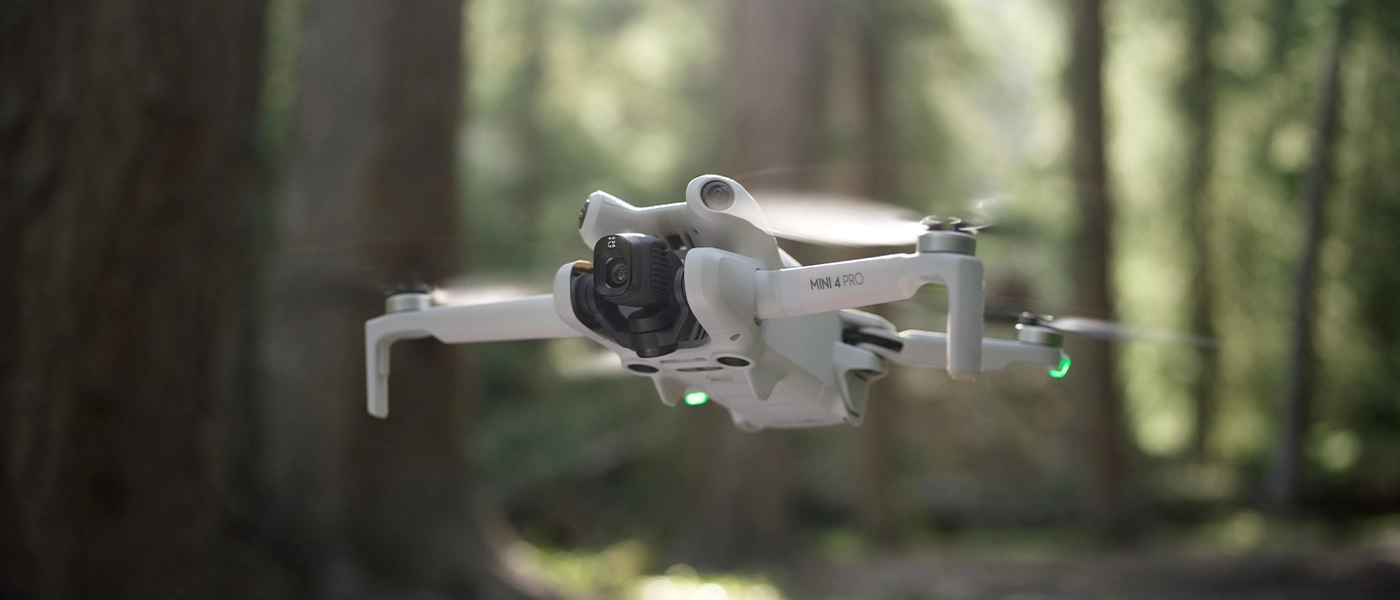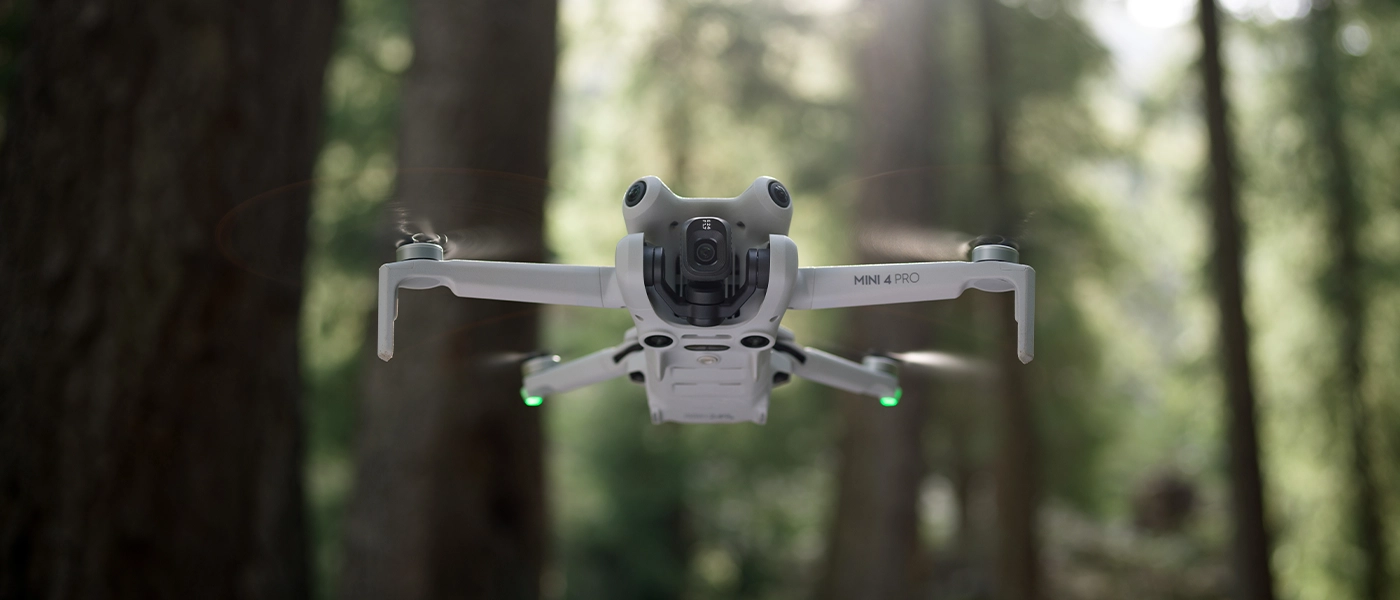DJI Mini 4 Pro - MegaDron review

New DJI Mini 4 Drone Pro is of great interest. No surprise, as it is definitely an improved version of its predecessor, the Mini 3 Pro. First impressions are very positive. First of all, you will immediately notice that the drone seems to be much quieter than its predecessor, which certainly affects your own and third parties' comfort and enjoyment of flight. This is one of the first tidbits we noticed after the first few minutes with the drone.
Safety first
The Mini 4 Pro is equipped with lED placed on the bottom side, which allows much better orientation in the air and makes it easier to fly after dark. Another significant improvement is the 360° sensors, which enable much more reliable flight near objects. Of course, there is a certain margin of error, so they won't always pick up small obstacles such as tree branches (care should always be taken), but they nevertheless improve flight safety and minimize the risk of collisions.
As for the control of the drone, it is very easy to use as standard. We used the latest controller DJI RC-N2, included. This is the new camera released with the previous release of the DJI Air 3, which we write about herein. Controls are the same as the older Mini series drones (excluding the DJI Mini 1) provide great control as standard. A variety of commands can be executed without delay or difficulty, making the Mini 4 Pro very friendly for pilots with different levels of experience.
Spherical sensors, are located at an angle and provide a wider field of view. It is worth noting that this is the first drone in the mini series that allows 360° obstacle detection. Previously, only more expensive drone models had such a feature, such as DJI Mavic 3 Pro, or DJI Air 3.
As you can see in the video below, in a situation where we tried to fly into an obstacle, the drone automatically prohibited it. Obstacles were shown visually on the screen, which helps to better control the drone.
DJI Mini 4 Pro Camera
After testing the new drone Mini 4 Pro we would like to point out that the camera of this drone has the the same module camera what the Mini 3 Pro version. Equipped with a 1/1.3-inch CMOS sensor and Dual Native ISO Fusion, it provides very satisfactory image quality. You can compare the size of this sensor to the cameras of flagship, latest phones. Even in difficult situations, the Mini 4 Pro handles very well. The f/1.7 aperture and 2.4 μm 4-in-1 pixels allow you to capture really good shots. The main difference here lies in the frame rate of the recordings.
Despite its small size and weight, the Mini 4 Pro delivers recordings in resolution 4K/60FPS HDR (with the mini 3 Pro being 4K/30FPS) and the effect of slow motion in 4K/100FPS. D-Log M and HLG modes enhance image quality. We will take 48MP RAW photos as standard.
Like the previous model, the gimbal can tilt 60 degrees up and 90 degrees down, and the camera rotates 90 degrees to provide full vertical resolution for social media.
DJI Mini 4 Pro drone camera has met our expectations in terms of video and photo quality, although of course we did not expect much more than in the previous model in the series. The higher frame rate of the new drone will trim especially for those who know that they will create more dynamic shots more often and fly the drone quickly. The biggest differentiator and, at the same time, what would entice us to buy this drone, are the following obstacle detection sensors.
Construction and capabilities
Mini 4 Pro weighs less than 249 grams, which allows you to fly in c0 subcategory. The new model has a certification mark on the bottom. This is the first Mini drone with official, mandatory certification, which will already be mandatory from the beginning of 2024.
The four front- and rear-facing sensors are now positioned so that they can also see to the sides, top sensors have been added, and the housing is slightly more streamlined. The drone has larger cooling vents, slightly smaller rear arms and new supports on the front. Both the camera/gimbal and propeller covers are smaller and easier to put on. The same propellers as the mini 3 Pro are used, so they can be interchanged between models and will certainly be easily accessible.
On the back of the Mini 4 Pro is a microSD port and has 2 GB of internal memory for the forgetful, in case you run out of memory cards or run out of space on them.

Range and control of the drone
The new apparatus allows as much as 10 km range. The Mini 4 Pro is available with one of two new controllers: the basic RC-N2, which requires a smartphone, and RC 2 with built-in screen. Aside from better antennas, the old and new instruments are no different-the buttons are located in the same places. The drone and camera use the new o4 transmission from DJI, first introduced in the Air 3, so it only works with the new controllers. For the time being, the DJI Mini 4 Pro drone will not work with older camera models, and such a change may come in the future.

Photo taken with DJI Mini 4 Pro
DJI Mini 4 Pro performance
Because of its small size and maneuverability, the Mini 4 Pro can be treated as a flying sports camera. The light weight and low price compared to the Mavic 3 Pro, for example, makes the drone very attractive relative to the competition. The maximum speed is about 16 m/s (57.6 km/h) , can cope with winds of up to 10.7 m/s (38.5 km/h), which is a impressive result for a drone weighing less than 249 grams. In action, it can sometimes appear to be heavily swayed by the wind, but you won't see that in the footage thanks to the DJI gimbal and stabilization technology. The drone also uses aPAS system from DJI, which offers automatic braking and obstacle avoidance for added safety.

Obstacle detection
In the case of the DJI Mini 4 Pro, you get wide-angle 360° obstacle detection sensors, which, due to its location, provide wider vision than other mini drones. At the same time, compared to equipment requiring much more money, such as the DJI Mavic 3 Pro, the vertical field of view of the sensors is smaller (for example, the front and rear sensors on the Mavic 3 Pro are 103° vertically, and the DJI Mini 4 Pro is 72°). The new drone will detect obstacles by flying at a minimally slower speed than higher-end drones (15 m/s on the Mini 3 Pro and 12 m/s on the Mini 4 Pro).
However, let's not forget that this is the first mini drone with sensors on each side, while maintaining such a low weight. Certainly their sensitivity, measurement range and speed have been improved over their predecessor, the DJI Mini 3 Pro. Finally, it is worth mentioning that the DJI Mini 4 Pro is the first to be equipped with an additional 3D infrared sensor, which can be helpful when taking off and landing.
Megadron Specialist Council:
"It is important to remember that obstacle detection sensors cannot be relied on 100 - percent. That's because these types of sensors are great for larger surfaces such as a wall or a car, while small obstacles such as thin cables or a slender branch are no longer so easily detected. The second aspect is the speed at which the drone moves - recording in cine (movie) mode, when the drone moves smoothly, there is almost no chance of collision. The higher the speed, the lower the obstacle detection - the drone simply doesn't have time to process the information and stop (all these mechanisms take milliseconds)."
Battery life
The batteries used in the Mini 4 Pro are almost identical to those used in the Mini 3 Pro, so if you already have some batteries, you can save some money. Flight time is very similar, the battery should last about 30 minutes. The manufacturer states a maximum flight time of 34 minutes, but it is better to be prepared for 24-28 minutes of flying time. The Mini 4 Pro battery weighs approx. 77.9g, and its capacity is 2590 mAh, while the battery from the Mini 3 Pro weighs approx. 80.5g and has 2453 mAh. Using the battery from the older model in the DJI Mini 4 Pro, the weight will exceed 249g! Flying is still possible, but it is worth knowing that the weight will be exceeded.
Mini 4 Pro - pros and cons of the drone
New Mini, combines many new features from professional drones. Here's an overview of the pros and cons of the DJI Mini 4 Pro drone to help you understand why you should pay attention to it:
| Disadvantages | DJI Mini 4 Pro | Advantages |
| - quality in night scenes could be better |  | + quiet |
| + advanced 360° obstacle avoidance | ||
| + gimbal with up to 60° upward tilt | ||
| - limitation of object tracking 50 m | + easy control | |
| + ActiveTrack 360° object tracking | ||
| + solid image quality | ||
| - is not reliable during collisions | + large stable range | |
| + 1080p/60FPS video streaming | ||
| + creating vertical shots |
Summary
We have this! Finally, a mini drone that has sensors on each side! Plus, tracking the object from all sides. These two parameters were what we expected the most and we were not disappointed. Significantly lower noise level, easy operation. In fact, the only thing missing are the camera enhancements already found in higher-end drones such as the DJI Air 3. The drone's performance can match some professional drones, and its maneuverability and low price compared to the competition attract attention. This is a drone worth looking into without illusions, and we will use it more than once.




